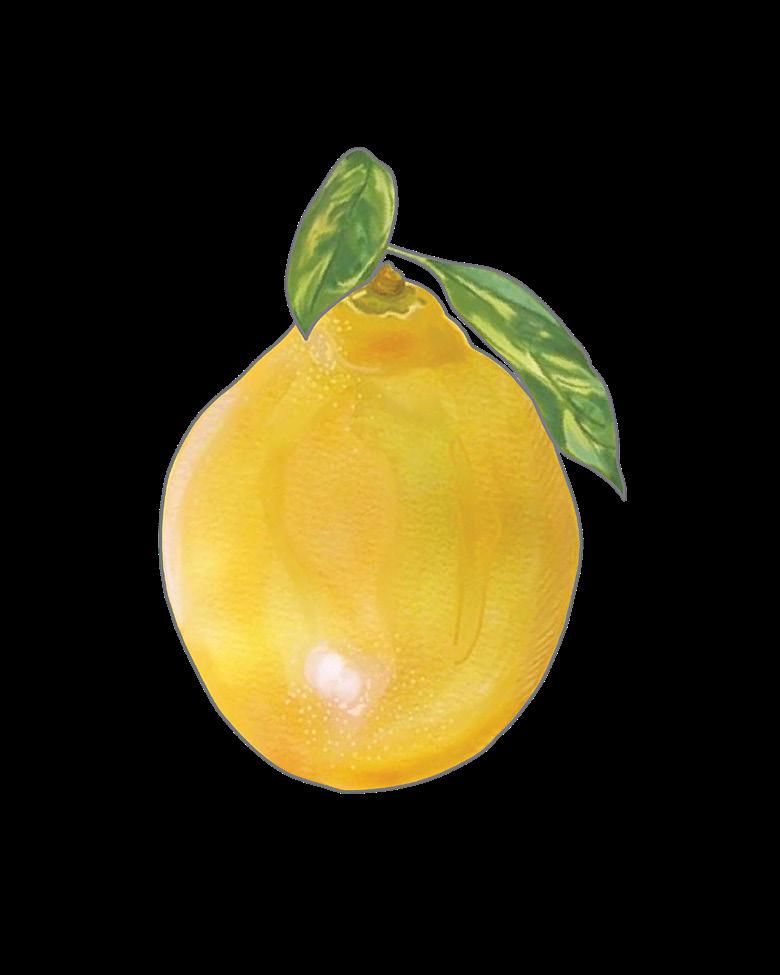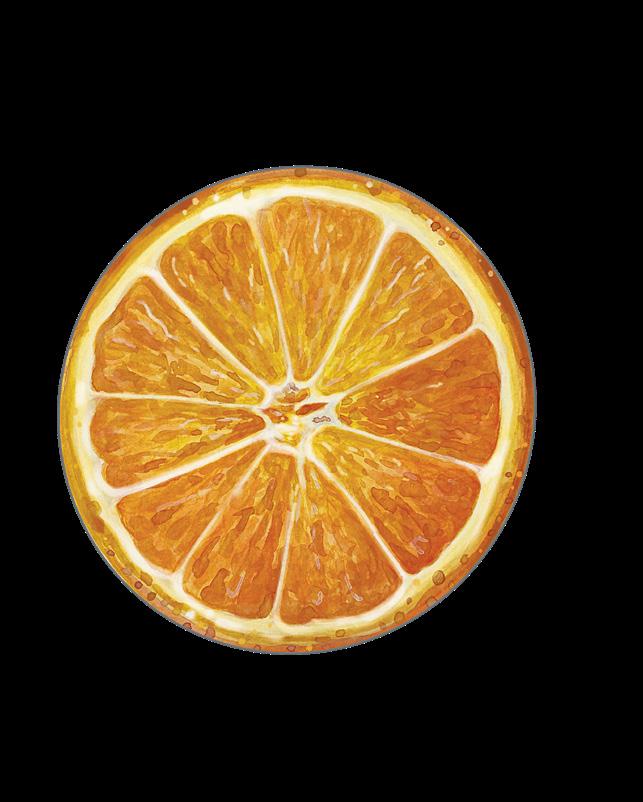
4 minute read
Fresh Market: Citrus
Citrus
By ELLEN KELLY Illustration by ALISON MARTIN I've often written about citrus this time of year. Honestly, it's hard not to. These juicy globes of sunshine come into season in California, Texas and Florida during our winter months and what a blessing it is. Childhood memories of that first box of much anticipated “Japanese” oranges at Christmas aside, they appear when we need them the most.

We see pomegranates and persimmons from afar, but nothing is so essential to our well-being as that hit of citric acid in January and February. Winter is the time when all citrus starts to make a bigger contribution. We begin to find kumquats, Meyer lemons and Ruby Red grapefruit amongst the regular fare. Even Valencia and navel oranges up their game. This year, I’ve actually seen fresh bergamot and yuzu (for the curd and marmalade aficionados), but these require a little more determination to track down. Call Isaac Bignell at Say Cheese Fromagerie for updates and stories. Though we see citrus all year round, this is the time to indulge. Adding orange, grapefruit, lime and lemon to everyday salads, baking and desserts goes a long way to alleviate the tedium of our long winters. Marmalade makers, start checking for Seville oranges about now; they’re here and gone in a trice. Thinking about Christmas cookies (which is often all I actually do) brought me circuitously to a crinkle lemon version of a chocolate standard that would be perfect to make for Easter or any spring celebration. If you’ve ever made chocolate crinkle cookies, you’ll get the process. If not, the key things to remember are as follows: Get as much icing sugar on the dough as you can; don’t shake it off after rolling the balls in it. Cool the cookies completely on the baking sheets before transferring them to a container. And don’t press the balls of sugar-covered dough with a fork, as tempting as it might be, on the baking sheet - leave them round. Preheat your oven to 160 C (325 F). Sift 575 ml (2¼ cups) of flour with 7 ml (1¼ tsp) baking powder and 4 ml (¾ tsp) fine sea salt. Cream (room temperature) 50 g (8 oz) cream cheese and 150 ml (10 Tbsp) soft butter until fluffy, about 2-3 minutes. Add 2 beaten eggs, 5 ml (1 tsp) vanilla, 10 ml (2 tsp) lemon zest and 60 ml (¼ cup) fresh lemon juice. Mix in dry ingredients until just combined. Refrigerate the dough, covered, for at least 2 hours or overnight. Put about 250 ml (1 cup) icing sugar in a pie plate. Roll balls of dough about the size of a ping pong ball and

And the winner is...
Congratulations to Wing Yeen, the winner of last issue's pop quiz. Here are the correct answers: 1. Nutmeg is native to which country? Indonesia. 2. Cinnamon is taken from which part of the tree bark? The inner bark. 3. The tradition of baking and decorating a gingerbread house originated in which country? Germany. roll in the powdered sugar. Let them sit for 5 minutes or so and then roll them in the sugar again. Place them on a parchment covered baking sheet 5 cm (2 inches) apart and bake for 20 minutes. Cool on the baking sheets before removing. Grapefruit tends to be a little under-rated, possibly due to being foisted on several generations as a diet food. It is, in fact, an uplifting addition to so many things, not least a simple cocktail (think Greyhound) or unusual marmalade. It’s pleasantly bitter, floral taste goes well with seafood, too. Grapefruit is low on the glycemic index which means it doesn’t affect blood sugar levels. Alas, some people need to take care as grapefruit doesn’t react well with some prescription drugs. Checking with your pharmacist (they know all) is usually a good idea. It’s likely a hybrid of a pomelo and a sweet orange and has been referred to as the “forbidden fruit.” Oh, and it’s the state fruit of Texas! At least the sweet dark red variety is. An absolute favourite salad of mine this time of year is a combination of sweet red grapefruit, perfectly ripe avocado, and gloriously plump pink shrimp, served on pretty leaves of Boston or Bibb lettuce. A light vinaigrette made with a small amount of finely chopped shallots, white balsamic vinegar, grapefruit juice (collected from sectioning the fruit) and a light grassy olive oil. To serve, arrange the elements however it pleases you on top whole leaves of the lettuce. Simple and classy in pretty pinks and greens. To section a grapefruit, or any citrus fruit, only requires a sharp paring knife and a little determination. Cut off both stem and blossom end just to the flesh. Set fruit upright on one flat end and peel by carefully drawing the knife down from top to bottom, removing as much of the white pith as possible without cutting away too much of the flesh. You can trim it up when you’re finished with the tricky bit. (This peeling method works for melons and pineapples, as well, with very few alterations). Hold the peeled fruit in the palm of one hand over a bowl and gently cut away the segments of flesh from the membranes. Squeeze out the juice into the bowl to use in the dressing. CHECK OUT ELLEN'S SEVILLE ORANGE MARMALADE RECIPE

4. Which fairy tale is said to have started the gingerbread house tradition? Hansel and Gretel. 5. In which decade did we start leaving cookies out for Santa? 1930s, during the Depression
Check out this month's quiz on Page 15.



